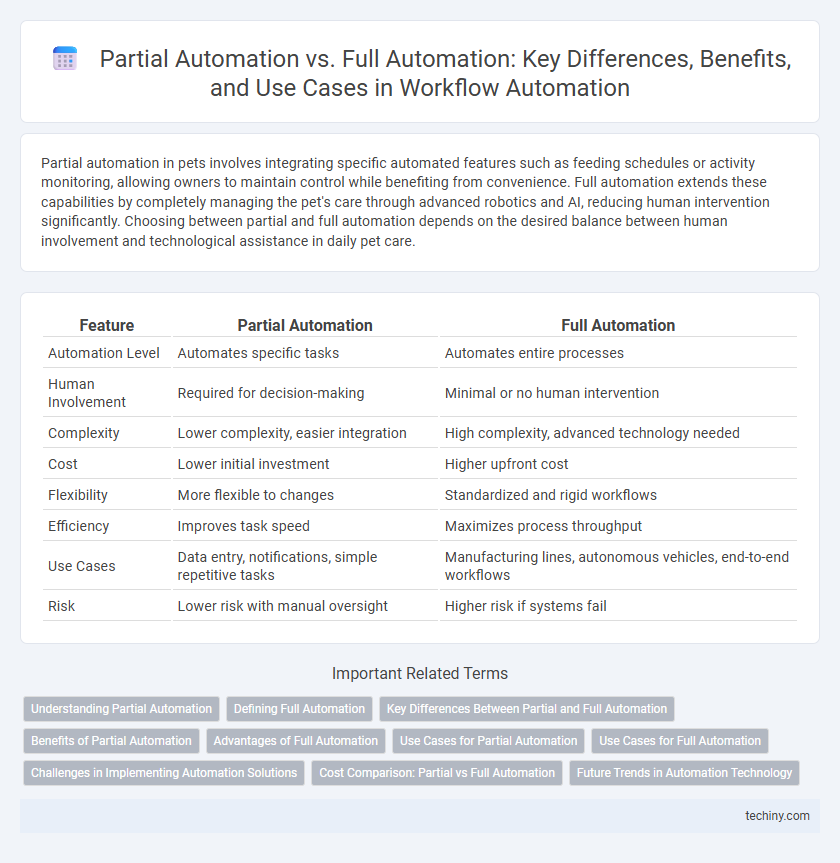Partial automation in pets involves integrating specific automated features such as feeding schedules or activity monitoring, allowing owners to maintain control while benefiting from convenience. Full automation extends these capabilities by completely managing the pet's care through advanced robotics and AI, reducing human intervention significantly. Choosing between partial and full automation depends on the desired balance between human involvement and technological assistance in daily pet care.
Table of Comparison
| Feature | Partial Automation | Full Automation |
|---|---|---|
| Automation Level | Automates specific tasks | Automates entire processes |
| Human Involvement | Required for decision-making | Minimal or no human intervention |
| Complexity | Lower complexity, easier integration | High complexity, advanced technology needed |
| Cost | Lower initial investment | Higher upfront cost |
| Flexibility | More flexible to changes | Standardized and rigid workflows |
| Efficiency | Improves task speed | Maximizes process throughput |
| Use Cases | Data entry, notifications, simple repetitive tasks | Manufacturing lines, autonomous vehicles, end-to-end workflows |
| Risk | Lower risk with manual oversight | Higher risk if systems fail |
Understanding Partial Automation
Partial automation involves integrating automated systems to handle specific tasks within a broader manual process, enhancing efficiency without complete human disengagement. This approach allows for flexible human oversight and decision-making while reducing repetitive labor and error rates. Understanding partial automation is crucial for optimizing workflows where full automation may be impractical due to complexity, cost, or the need for human judgment.
Defining Full Automation
Full automation refers to systems where machines or software perform all tasks within a process without human intervention, ensuring continuous operation and consistent output quality. It encompasses advanced technologies like artificial intelligence, robotics, and machine learning, enabling decision-making and error correction autonomously. Full automation significantly enhances efficiency, reduces labor costs, and minimizes human error compared to partial automation, which still requires manual oversight or input.
Key Differences Between Partial and Full Automation
Partial automation involves the use of automated systems to perform specific tasks within a process, allowing human intervention and control at critical points, whereas full automation eliminates the need for human involvement by enabling machines to independently execute entire workflows. Key differences between partial and full automation include the level of human oversight, system complexity, and scalability, with full automation typically requiring advanced artificial intelligence and integration capabilities. Partial automation suits scenarios needing flexibility and human judgment, while full automation maximizes efficiency and consistency in repetitive, high-volume operations.
Benefits of Partial Automation
Partial automation enhances operational flexibility by allowing human oversight and intervention during complex tasks, reducing the risk of errors. It enables cost-effective implementation by automating repetitive processes while preserving human judgment for critical decision-making. This approach supports gradual workflow optimization, increasing productivity without requiring complete system overhaul.
Advantages of Full Automation
Full automation enhances operational efficiency by enabling continuous, error-free processes that reduce human intervention and labor costs. It improves productivity and consistency through advanced AI and machine learning integration, allowing systems to adapt and optimize in real time. Enterprises adopting full automation benefit from scalable solutions that deliver faster turnaround times and higher quality output across diverse industries.
Use Cases for Partial Automation
Partial automation enhances operational efficiency by automating repetitive and time-consuming tasks while retaining human oversight for decision-making and quality control. Common use cases include customer service chatbots that handle routine inquiries, manufacturing assembly lines where robots manage specific tasks but humans oversee the process, and financial services automating data entry while analysts interpret results. This approach balances productivity gains with flexibility and error management, making it ideal for complex environments requiring human judgment.
Use Cases for Full Automation
Full automation excels in repetitive, high-volume manufacturing processes such as automotive assembly lines and electronic component production, where consistent precision and speed are critical. It is also pivotal in data center management and software deployment, enabling continuous integration and delivery without human intervention. In logistics, full automation optimizes warehousing and order fulfillment by utilizing autonomous robots and AI-driven inventory control systems.
Challenges in Implementing Automation Solutions
Implementing partial automation often faces challenges related to integrating automated systems with existing manual processes, leading to inconsistent workflow and increased complexity in coordination. Full automation demands significant investment in advanced technology and infrastructure, posing risks of high upfront costs and extensive employee retraining. Both approaches require robust cybersecurity measures to protect against vulnerabilities introduced by interconnected systems and the potential for operational disruptions.
Cost Comparison: Partial vs Full Automation
Partial automation typically involves lower initial investment and maintenance costs compared to full automation, making it more suitable for small to medium-sized enterprises. Full automation requires significant upfront capital expenditure for advanced robotics, software integration, and system maintenance, but offers greater long-term cost savings due to higher efficiency and reduced labor expenses. Evaluating total cost of ownership, including implementation, downtime, and scalability, is crucial when comparing partial versus full automation solutions.
Future Trends in Automation Technology
Future trends in automation technology indicate a gradual shift from partial automation, which combines human oversight with machine operations, toward full automation where systems operate independently with minimal human intervention. Advancements in AI, machine learning, and robotics are driving this transition, enabling more sophisticated decision-making and enhanced operational efficiency. Industries adopting full automation anticipate reduced costs, increased productivity, and improved safety, signaling a transformative impact on the global workforce and manufacturing processes.
Partial Automation vs Full Automation Infographic

 techiny.com
techiny.com